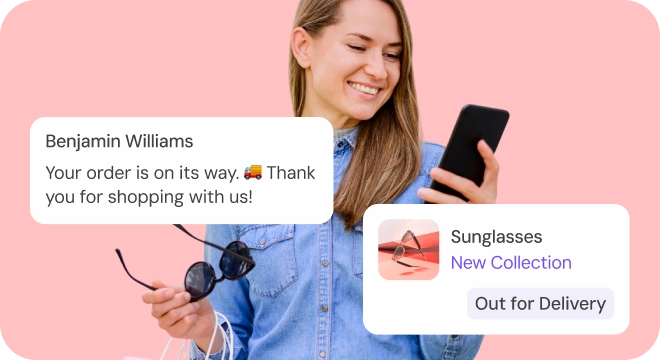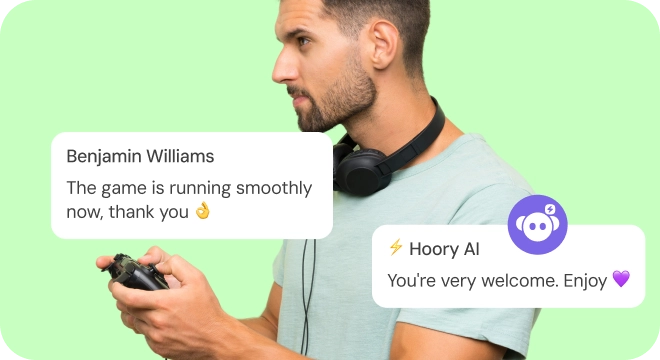8 Customer Support Trends for 2025
• Customer Support
• FastBank

Is your customer support the best it could possibly be? Is every support interaction a perfect experience for each customer? Are all your competitors scratching their heads trying to keep up with the quality of your customer service? Unless you answered yes (in which case, bravo!) to all three questions, here are ten trends you can start incorporating into your support processes, technologies and approaches to get your customer service that much closer to perfect.
From emotionally intelligent AI-powered chatbots to immersive VR experiences, here are the customer support trends you need to follow in 2023.
Emotionally Intelligent AI Chatbots
Remember when all chatbots did was provide pre-written answers to a pre-decided set of questions? Well, it’s time to forget all that. The new edition of AI chatbots, often referred to as AI assistants or AI customer support agents, are surprisingly adept at not only answering a much larger pool of questions, but also identifying customer emotions and tailoring their responses accordingly.
How? Well, one of the answers is ChatGPT. This increasingly powerful AI is not only exceptionally good at mimicking human language, but also analyzing user requests for tone of voice and intent. As a result, support assistants like Hoory that use ChatGPT integrations can engage in human-like interactions with your customers, providing them with a similar level of care and empathy as your human agents.
Our Tip: Do not think of chatbots as something that can replace your agents. No technology can, at least for now. Instead, think of them as something that can help you increase your support capacity and free your agents from repetitive tasks, all with a minimal increase in costs.
Hyper-Personalization Through Data-Guided Insights
As customers grow persistently vocal about their disdain for one-size-fits-all solutions and generic approaches, personalization has become one of the most frequently used buzzwords in the world of customer support. In 2023, when personalization is more of the new normal, than a trend, a new phrase is entering the customer support vocabulary.
Meet Data-Driven Hyper-Personalization, a trend set to become a key focus for businesses that prioritize customer care. In a nutshell, this is the process of gathering, storing and analyzing rich data on the behavior, preferences, support history, communication patterns and satisfaction scores of each individual customer, and using this to build highly personalized experiences, usually through advanced AI tools.
Our Tip: To avoid unnecessary spending, invest in an AI-powered customer support solution that comes with data storing and analysis capabilities, instead of using a separate data tool. For instance, the Hoory AI assistant offers comprehensive data gathering and reporting features, in addition to other customer support necessities. And once you’ve got all the data-driven insights, why stop at customer support? Use them to create personalized ad campaigns, loyalty programs, promotions and more.
Machine Learning to Improve Customer Experience
Let’s start with a quick definition. In layman’s terms, Machine Learning is everything that allows computers to learn and improve from experience, as opposed to explicit programming. The reason why ML is starting to play an increasingly pivotal role in the customer support landscape of today is tied up with the above-discussed trend of hyper-personalization. By deploying ML, you can not only automate the process of data-driven personalization, but also use past data to make accurate and actionable predictions about customer behavior.
Our Tip: One of the most useful ways you can leverage machine learning is customer churn prediction. Through comprehensive behavior analysis and pattern recognition, ML can help your agents identify potential churners (customers who are most likely to stop doing business with you) and take proactive measures to prevent loss of business.
Mobile-First Support
Mobile-friendly customer support is so 2022. To stay on top of the game (or even in the game) today, it’s not enough to just adapt your existing processes to mobile channels . Instead, your customer support has to be fully built around the needs and behavior of mobile users. This means integrating features like in-app messaging and push notifications, providing fast-loading solutions that consume less data, making interactions more streamlined, as well as ensuring that response times are quick enough to satisfy on-the-go customers.
Our Tip: Instead of redesigning your website/platform for better mobile experiences, invest in an all-in-one customer support solution to add a lightweight widget to your existing website that works perfectly on all mobile devices.
Omnichannel Support
Yes, omnichannel support is in no way a new trend. But, until provision of seamless customer care experiences across a wide range of channels and devices becomes an industry norm, you can expect to see this headline in every list of customer services trends. And in case you need convincing that omnichannel is the way of the future, consider these two facts:
First, a recent study by Harvard Business Review revealed that customers that interact with a company through multiple channels are 30% more valuable (in terms of average lifetime value) than those using a single channel.
Second, according to Microsoft, 93% of customers expect brands to provide consistent customer support on every channel/platform they have any presence on.
What does omnichannel support mean in practice? Essentially, it means having one centralized system to receive and respond to customer queries, no matter where they originate. And while such a system can be quite costly and time-consuming to build from scratch, you can leverage user-friendly tools like Hoory to give your agents a bird's-eye view of all customer interactions, from live-chat to email, social media channels, messaging apps and more. And all that, without any coding or having to break the bank.
Our Tip: Technology does wonders, but it’s not enough to ensure truly consistent and integrated communications. Make sure to train your support agents (and your AI assistant) to maintain coherence and continuity across all channels.
Multilingual Customer Support
Not so long ago, high-quality multilingual support was a luxury that only global corporations could afford. After all, recruiting, training and maintaining a multilingual support team is neither easy, nor cheap. Same goes for all the efforts necessary to upgrade or modify existing infrastructure and technology to accommodate multilingual operations.
However, recent improvements in language processing technologies employed by advanced customer support solutions like Hoory have made it easier and less costly to cater to diverse linguistic preferences. Multilingual AI Assistants now enable businesses to provide seamless support in multiple languages, enhancing accessibility and customer satisfaction.
These advancements in tech, combined with the growing demand among customers for support communications in their native language (a study by Common Sense Advisory found that 74% of customers are more likely to make a purchase if customer service is provided in the language of their choice) have turned multilingual support from a luxury into a necessity.
Our Tip: As you make the transition to multilingual customer support, make sure to invest in comprehensive cultural sensitivity training. Train your agents and your AI assistant to respond to international customers in a way that demonstrates respect towards their culture, and watch how this leads to improved customer satisfaction and brand loyalty.
Video Customer Support
While many of the above-described trends are about freeing up time for agents to focus on high-priority clients and cases, this one is about helping your agents use that time to connect with customers in more meaningful and effective ways.
Video customer support not only allows for in-depth exploration of complex cases, but also makes the support experience more personalized, making customers feel more heard, understood and valued. It is no wonder that according to a HubSpot survey, 54% of customers prefer video support over other communication channels.
Our Tip: The best way to make your video support fit seamlessly with your overall customer service system is using a one-stop solution that allows your agents to initiate and respond to video calls in the same dashboard they use for everything else, without switching to another app/platform.
VR Customer Support
According to Accenture, over half (64%) of well-known consumer brands have started investing into augmented reality, virtual reality, 3D content, and 360-degree videos. With its potential to provide truly immersive experiences, this technology is becoming more and more popular for customer support. With VR support, customers can interact with support agents in a virtual environment, creating a more personalized and lifelike encounter.
Due to VR, customers can visualize complex issues and receive step-by-step guidance, making problem-solving more efficient. This can be exceptionally beneficial in technical support cases, like setting up advanced electronic devices or troubleshooting software glitches.
Our Tip: While VR can be quite costly, if used strategically, it can help you reduce your customer support costs. For instance, by transcending geographical barriers, VR can reduce the need for on-site visits, saving you time and money.
Challenges of Adapting to New Trends
Change is as difficult as it is inevitable. But as tricky as adopting new technology, approaches and processes might be, there are always steps you can take to make things easier for your team and your customers.
-
Be open with your team. Discuss every (potential) change beforehand and create a safe space for your agents to express their opinions and ask for support.
-
Foster a culture of innovation and agility, continually encouraging your team to embrace new technologies and adapt to changing customer needs.
-
Invest in continuous training and upskilling of support teams to handle emerging technologies and deliver exceptional customer experiences.
-
Strike a balance between AI-powered automation and human interactions, recognizing when personal touches are indispensable.
Final Thoughts
In the ever-evolving landscape of customer support, you either adapt and innovate, or you risk falling behind and losing your competitive edge. Embracing new technologies, staying customer-centric, and continuously improving your support strategies are essential to meet the ever-changing expectations and demands of modern customers.
Stay tuned and read our blog for valuable insights and useful tips! Don't miss out on the latest knowledge to level up your skills and knowledge.

























